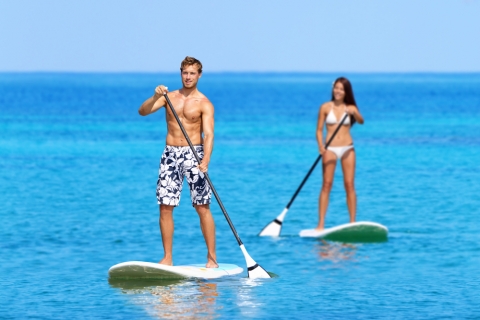Paddle surfing or paddle surfing as it is called in Spanish, is a form of sliding in which the athlete uses a paddle to move through the water while standing on a surfboard. According to the story, this sport was born when surf instructors stood on the boards in order to have a better visibility of their group. Over time the surfers began to incorporate it as a way to train their balance and over the years became an official sport. However, it differs from surfing since it can be done in calm waters without the need to have waves.
As in the kayak, when choosing the table we should think about our experience, our objective and the physical context of the person. It is good to start with a large volume table, generally have a rounded shape and are much wider in the central part, offering greater stability. As more experience is acquired, the table changes its forms and measures.
The blade used must take into account the height of the athlete since the length of this must exceed it by at least 20 cm. In turn they can be made of different materials such as plastic, aluminum, wood, fiberglass, carbon, rigid or adjustable size.
On a physical level, paddle surfing is considered one of the most complete activities, because the whole body is worked, both the upper and lower train. The biceps and triceps are used during the action of rowing as well as the back and the backs. The abdominals should always remain tense when doing the work of keeping us balanced on the table. It seems something very easy to perform but requires the “paddler” a great muscular effort. Staying in balance while moving the paddle from one side of the board to the other requires a lot of skill.
Despite how complex this sport is, it is an easy activity to learn and does not require special physical abilities. It is suitable for people of all ages to practice. The most advisable thing is to start practicing in calm waters to keep gaining balance until the person manages to keep standing on the board. Then, the next step is to maintain balance while bending your knees. Finally, by passing the weight to the back of the board we can move slowly until we reach enough skill that it will make it easier to make turns and other maneuvers.
Since it can be done on any type of aquatic surface, be it the sea, rivers or lakes, in our province, the Mendoza River and the Atuel River are ideal places to practice river style. It is the most extreme form of paddle surfing, the descent of rivers. Very fun but also dangerous, not suitable for people who just start. It is advisable to use a helmet and other protective materials to avoid serious injuries in case of hitting a rock.
For the less risky, the Potrerillos Dam, the Carrizal and the Valle Grande Reservoir are ideal for the practice of ‘paddle surfing crossing’, a modality that allows you to spend a long period of time, even all day sailing on the board; or the most modern of the styles, the’yoga / fitness’, a modality that is gaining more and more followers, since it offers innumerable benefits when joining both activities, which implies maintaining the balance and at the same time performing the yoga postures.
In April 2017, the first amateur tournament in Mendoza was held in Potrerillos.






